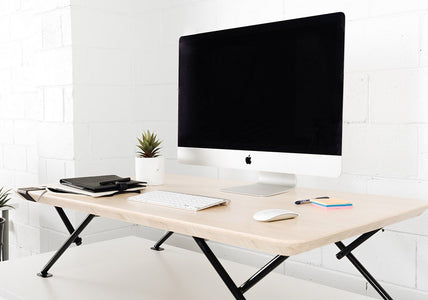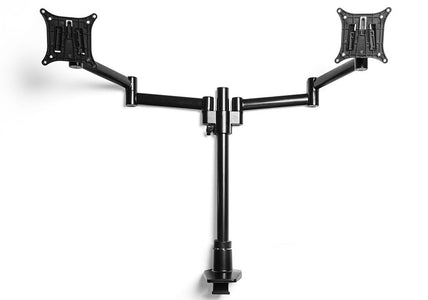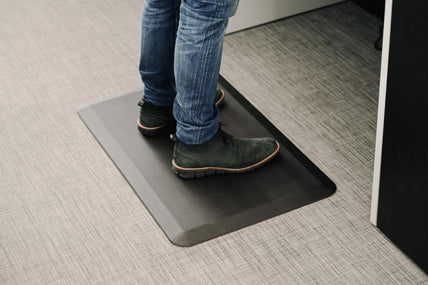Movi Workspace - 5 Effective Ways to Improve Your Work Posture—And Your Life!
By Daniel Angelini on September 07, 2020People are sitting now more than ever before. In fact, some studies show that the typical office worker sits for up to a whopping 15 hours a day. Furthermore, an analysis of 13 studies conducted by Mayo Clinic showed that “sitting time and activity levels found in those who sat for more than 8 hours a day with no physical activity had a risk of dying similar to the risks of dying posed by obesity and smoking.”
If you know you’re among those workers who spend hours sitting at their desks, these are just some of the plethora of studies warning you about the dangers of a sedentary lifestyle. Sitting for extended hours without breaks or physical activity is putting you at risk of chronic pain and other injuries in your muscles and tendons.
Here are just some of the problems and musculoskeletal symptoms that you may experience from a sedentary lifestyle:
- Misaligned spine due to eventual slouching after long hours of sitting
- Neck strain from a poorly designed workstation and computer monitors below eye level
- Hip misalignment from crossing ankles and legs
- Lack of adequate blood flow to spinal discs
If these things are left unaddressed, you could experience a serious impact not only on your productivity and performance but also your overall health.
The good news is that it’s still not too late for you to turn the situation around. There are steps you can take to mitigate long-term damage, even as you continue working. This is by reconsidering your workplace posture habits and adopting healthy ones based on ergonomic principles.
To help you get started, we’ve listed in the sections below some effective tips to reduce back and neck pain and, ultimately, make you feel good while at work.
- Start With Identifying What You’re Feeling
It’s good to start with your current situation. Be more aware of your wellbeing and keep track of any stiffness, pain, discomfort, or soreness that you are feeling in your back, shoulders, and neck. You can take this further by keeping a record of the symptoms along with the habit or posture that may have contributed to it.
Taking note of these minor details will help you understand the root of your pain. When you understand its cause better, you will be able to avoid it and find effective ways to improve your condition.
- Be Conscious of Your Posture
If your work involves the use of a computer, sitting is inevitable. However, if you sit for long hours with a misaligned spine from slouching, you may soon feel nerve pinching and muscle tension.
An effective way to avoid this is to practice a neutral posture. In the simplest words, this posture requires you to straighten up from head to toe. If you have a stand-up workspace, it shouldn’t be too difficult to practice this.
If you are sitting at a desk, there are still some ways to help you maintain a mostly neutral posture while working. One thing you can do is to elevate your computer monitor or laptop screen at eye level so that you will not have to look down. Moreover, keep your back flat against the chair and your feet flat on the ground.
Another thing to try is adding a lumbar support tool to your chair to keep you from slouching and help you maintain a straight upper back.
- Take Regular Movement Breaks
If you have a lot to finish for the day, you may want to keep sitting in front of your computer to get everything done. However, this is one bad workplace habit that could leave your body aching. Limited amount of movement puts you at a higher risk of back pain and other chronic diseases, so allow yourself to take breaks throughout the day.
Stepping away from your desk every 30 minutes can significantly help reduce incidences of lower back pain. Use this time to stretch your arms, open up your chest and back, and take a brisk walk around the room.
Forming this habit can be challenging, so if it helps, set a timer for your work blocks and your movement breaks. You can choose to set your own alarms for this one, or you can use smartphone or desktop apps that help you keep track of your work and break times.
- Invest in Ergonomic Supports
Ergonomic supports such as the lumbar support tool mentioned above can help you maintain a healthy posture when working. You may have a strong resolve to change your poor posture habits, but even so, it can be tough to train yourself to maintain a neutral posture all of the time. These supports will help you out during the first stage of establishing ergonomic sitting habits.
One interesting furniture that you might want to look at is the sit-stand desk. This is an adjustable desk that allows you to move around whenever you want to change your position. This desk makes it easy for you to switch from sitting to standing.
If you’re looking for a piece to add to your workstation, consider the MOVI standing desk!
- Build Your Own Ergonomic Workstation
After correcting your posture and considering support tools, set up your workstation while keeping ergonomics in mind. This will help ensure that the space where you work is indeed helping you make that challenging transition from poor posture habits to healthy ones.
The best thing about ergonomic workstations is that they are designed to fit you and your needs. When you’re building your work area or office, you take into consideration your unique body type and the space that will allow you a full range of motion. Your workspace should also give you enough room for your legs and feet and prevents you from slouching or hunching your back.
There’s a wide variety of ergonomic products in the marketplace, so you will be sure to find the pieces that will suit you and fit your personalized workstation just right.
Conclusion
These increasingly busy times may be demanding more from you, but this does not mean that you have to sacrifice your health and well-being for your work. If you have been experiencing pain in the neck, shoulders, and back, that’s a sign for you to reconsider your work habits and explore workplace ergonomics. These healthy habits will help relieve your muscle pain and make you feel good so that you’re always ready to give your hundred percent, whatever the day gives you.
Transforming your home office into a stand-up workspace? Check out our electric sit-stand desk! Here at MOVI, we convert desks into smart, automated-life standing desks that will surely improve your health and productivity. Get in touch with us today to learn how we can improve your workday!










